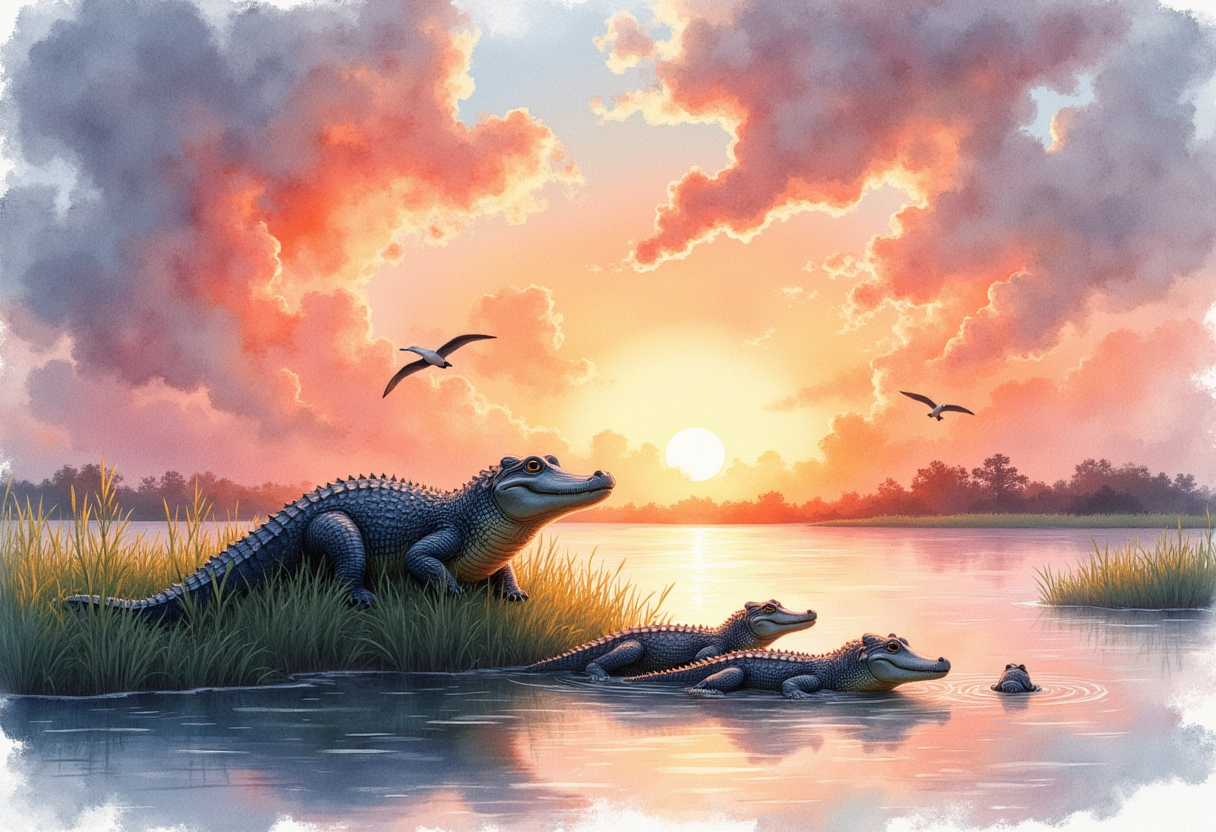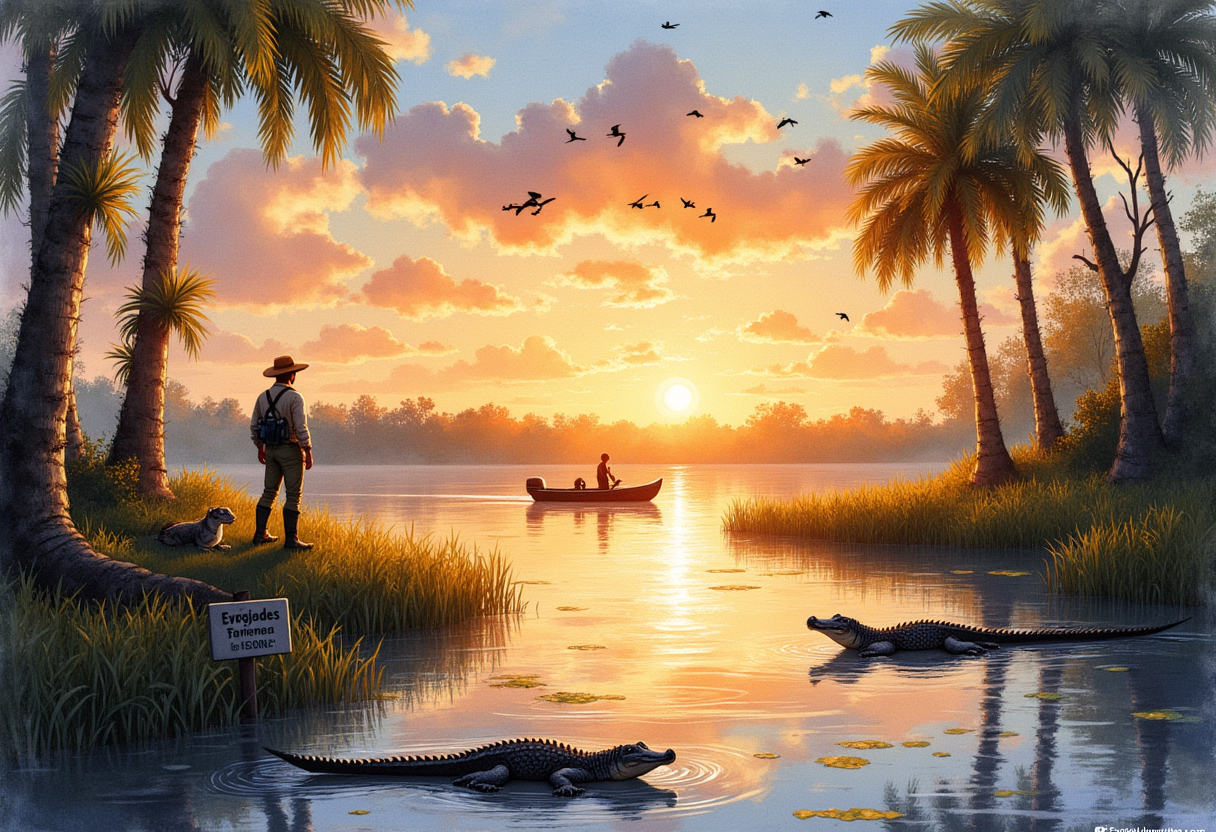“The Everglades: Nature’s Strangest Show”
An alligator emerges from the water during a radiant sunset
The Everglades: Nature’s Strangest Show
Mar 11
Everglades, Florida: a unique slow-moving river and wetland landscape that stretches across more than 1.5 million acres of South Florida. The Everglades — often called the “River of Grass” — carries fresh water from Lake Okeechobee down to Florida Bay, shaping habitats from sawgrass marshes to mangrove forests and hardwood hammocks.
It’s easy to miss the technical side when you’re staring into the muck, so here’s the short version: the Everglades is a living water system that filters and stores water for millions of people,
supports dozens of native species, and creates a patchwork of areas and trees that are critical to South Florida’s landscape and wildlife.
Have you ever been there boots-in-the-mud style? If not, imagine air thick as soup, sawgrass plains that ripple like a green ocean, and cypress domes dotted with trees that rise from the marsh like cathedral spires. The place hums with life — wading birds sweep the shallows, alligators loaf in gator holes, and tiny fish disappear underfoot.
Everglades Ain’t Just Water and Grass, Kid — It’s a Breathing Beast
The first time I wandered into the Everglades, I was 22, full of fire and foolishness, thinking I was gonna “find myself in nature.” What I found was a water moccasin that almost found me first — and a place that felt alive in a way city parks don’t.
That slow-moving river of sawgrass and mangroves makes the region’s seasons and conditions; during the wet season the landscape swells, and in the dry season gator holes and springs become lifelines for mammals, birds, and fish.
If you want stories, staying on the roadside won’t cut it. Walk a boardwalk, take a guided canoe trip, or visit a park trail inside Everglades National Park — you’ll read the headlines of the ecosystem with your own two feet. For background on the place and why we write about it, see About Florida Unwritten.
Get Everglades Stories & South Florida Wildlife News
Subscribe for untold tales from the Everglades, South Florida field notes, wildlife updates, and restoration news — delivered straight to your inbox.
Sign Up — Everglades & South Florida
A misty dawn in the Everglades, rendered in watercolor with gentle shading. Gnarly cypress trees with draping Spanish moss
We respect your privacy. Unsubscribe anytime. By joining, you’ll receive occasional updates about wildlife, restoration efforts, and on-the-ground stories from the park and surrounding areas.
The Everglades is a slow-moving river — a broad, shallow flow of fresh water that runs from Lake Okeechobee down to Florida Bay.
Locals call it the River of Grass, and its continuous sheet flow shapes habitats across more than a million acres of South Florida: sawgrass marshes, mangrove-lined estuaries, cypress domes, and hardwood hammocks.
That flow — the water that moves slowly through sawgrass and over limestone — is the backbone of the ecosystem.
In the wet season, the landscape fills and spreads; in the dry season, water concentrates into strands, springs, and the famous gator holes that become lifelines for fish, wading birds, mammals, and other species.
Habitats: sawgrass, mangroves, cypress, and hammocks
The sawgrass prairies look like a green ocean — endless blades that rise and fall with the water. Moving toward the coast, the sawgrass gives way to mangroves, which guard the estuaries and nurseries where fish and birds feed.
In slightly higher ground, you’ll find hardwood hammocks and stands of trees that host epiphytes, orchids, and migratory songbirds.
Recommended places to experience these habitats safely: the Anhinga Trail and Shark Valley boardwalk inside Everglades National Park, and the Big Cypress National Preserve visitor routes — short, accessible trails where you can watch the water, trees, and marshes at close range.
Wildlife: alligators, wading birds, and swamp specialists
The Everglades hosts a remarkable array of animals and birds adapted to water-driven conditions.
Alligators are ecosystem engineers: by digging gator holes in the dry season, they create water refuges that support fish and amphibians and attract wading birds.
Look for wading birds like herons and egrets in the shallows, and the flamboyant roseate spoonbill scooping mud with its long, pink bill.
The anhinga — often called the “snakebird” — fishes with its body submerged and neck extended. Because its feathers lack the oil layer many birds use for waterproofing, it perches with wings spread to dry, a common sight on logs and branches.
Seasons and conditions: wet vs. dry
The Everglades’ character flips with the seasons. During the wet season, usually from May to October, water spreads across the marshes, supporting breeding cycles for fish and waterbirds.
In the dry season, water retreats and concentrates into deeper pools and springs where reptiles, mammals, and birds gather — that seasonal rhythm is central to the ecosystem’s health.
A ranger stands in knee-high boots with binoculars slung at the ready, while a faded sign reads: "River of Grass – Everglades
Because water drives everything here — from plant communities to migration timing — protecting natural water flow is what conservation and restoration projects focus on. Altered flows change vegetation patterns, reduce habitat areas for key species, and affect the entire landscape.
Gators, birds, and oddball residents
Alligators are ubiquitous — you’ll often spot them lounging at the water’s edge or floating motionless. Their presence shapes local food webs and provides habitat for other animals. Wading birds patrol the shallows: kingfishers, herons, egrets, and ibises feed where fish concentrate.
These birds are both indicators of healthy water conditions and beloved draws for visitors and photographers.
Observers should respect wildlife: keep a distance from alligators and nesting birds, and use binoculars or a zoom lens rather than approaching animals. Boardwalks and guided tours inside Everglades National Park and Big Cypress routes offer safe, informative viewing opportunities.
Quick facts at a glance
Core function: natural water filtration and storage that supports South Florida communities and ecosystems.
Habitats: sawgrass marshes, mangroves, cypress domes, hardwood hammocks, and coastal estuaries.
Wildlife highlights: alligators, numerous wading birds, fish, mammals, reptiles, and dozens of native species that rely on seasonal water patterns.
You think gators are the kings of the swamp?
They used to be. But then someone in the ‘80s had the bright idea to buy Burmese pythons as pets. And when those snakes got too big — and buddy, they will get too big — people just dumped ’em.
Now, these snakes are everywhere, and they don’t give a hoot about your native wildlife. They eat raccoons, deer, birds, and even the occasional gator. That’s right — snake vs. gator. Nature’s equivalent of an MMA fight in a mud pit.
The government even started the Python Challenge — a contest to catch and remove the big ones. That’s right. We had to turn the Everglades into a game show to thin the herd.
Everglades: Where Even the Plants Get Weird
Have you heard of the ghost orchid?
The rarest flower in these parts. Grows up in the trees where no one can reach it. Bloom may bloom once a year. No leaves. No scent. Just hangs there like it’s too good for the rest of us.
And it kinda is.
These orchids are pollinated by one specific moth, which is so rare, that scientists throw actual parties if they manage to spot one doing its job.
You also got cypress knees — no, not a medical condition, though I’ve got those too. These are weird root growths that stick up like gnarled fingers from the ground around cypress trees.
No one entirely agrees with what they’re for, but they make the swamp look like it’s full of wooden gremlins reaching up from the mud.
Why the Everglades Matters More Than Your Beach House
A park ranger stands in knee-high boots, binoculars casually slung around the neck, observing the wildlife. A rustic sign, gently faded, reads “River of Grass – Everglades National Park
Now pay attention, because this part’s important.
The Everglades isn’t just some wild, funny, strange place. It’s essential. It filters fresh water for more than 8 million people in South Florida.
It acts like a sponge when hurricanes hit, soaking up floodwaters and keeping them from swallowing towns whole.
It provides habitat for dozens of endangered species, from the elusive Florida panther to the slow-motion sea potato we call the manatee.
And despite everything we’ve thrown at it — highways, pollution, sugarcane farms, golf courses — the Everglades hangs on.
Folks are finally trying to fix what we broke.
The Comprehensive Everglades Restoration Plan (CERP) is the largest ecosystem restoration effort in the world, an ongoing partnership between federal and state agencies aimed at restoring natural water flow,
cleaning pollution, and reconnecting the system so the Everglades has a fighting chance.
CERP and related projects (many coordinated with the National Park Service and the South Florida Water Management District) focus on restoring sheet flow across the landscape, improving water quality for fish, birds, mangroves, and downstream estuaries, and protecting habitat for species such as the Florida panther and manatee.
Visiting the Everglades: Bring Bug Spray and Leave Your Ego
If you’re thinking of heading down there yourself — and we recommend you do — plan visits around habitats you want to see: Shark Valley and the Anhinga Trail inside Everglades National Park, or the visitor routes at Big Cypress National Preserve. Boardwalks and guided tours let you watch birds, alligators, and the water-driven ecology without disturbing animals or fragile trees.
Remember: the Everglades follows the seasons. The wet season brings high water and prolific bird breeding; the dry season concentrates wildlife around remaining water, making it a great time to see alligators and shorebirds at gator holes and springs.
If you want to help: consider reporting python sightings to the Florida Fish and Wildlife Conservation Commission, join volunteer restoration events, or support organizations working on comprehensive Everglades restoration projects. Small actions add up toward protecting water, land, and habitat across South Florida.
Why the Everglades Matters — Fast Facts
Water for people: the Everglades system supports water supplies and natural filtration that underpin life for millions across South Florida.
Habitat & species: dozens of native species — from wading birds and fish to mammals like the Florida panther and manatee — rely on connected habitats and seasonal water patterns.
Storm protection: marshes and wetlands absorb and slow floodwaters during hurricanes and heavy rains, protecting developed areas.
Restoration scale: CERP and partner efforts are among the largest environmental restoration projects in the world, focused on restoring sheet flow and improving water quality across vast areas of the Everglades and Big Cypress regions.
It’s a long road. The Everglades National Park, National Park Service, state agencies, and nonprofits are all working together, but restoring natural water flow and protecting habitat across these lands takes time, funding, and public support.
So come see the Everglades — respectfully. Learn about the ecosystem, support restoration efforts, and remember that the river of grass is more than a backdrop for your trip: it’s the water-fed heart of South Florida’s landscape.
Thanks for reading. Until next time, keep exploring Florida's peculiar charm.
Earl Lee
Florida Unwritten Staff
Earl LEE




